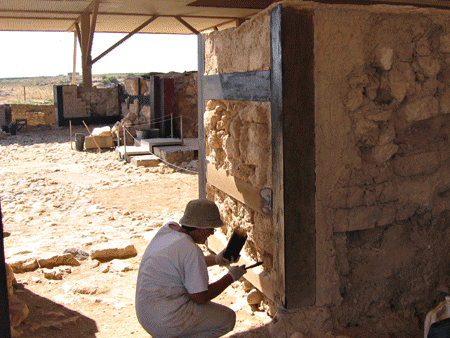|
 |
|
 |
| |
Are you
tantalized by a treasure hunt?
Many wannabe archeologists have been drawn
by the lure of buried treasure.
Perhaps the prime example is Montague Parker
who established a company in the early 20th
century by promising his investors that he
would divvy up the soon-to-be-found holy
land treasure among them. He claimed
that Solomon appeared to him during a séance
and revealed the site of the loot which
included David’s sword, Solomon’s crown, the
original tablets of the Ten Commandments and
the Ark of the Covenant.
By bribing one of the Moslem guards, Parker
attempted a nighttime dig under the carpets
of the El Aqsa Mosque on the
Temple Mount in Jerusalem.
It wasn’t long though, before the guard got
sick and was replaced by his cousin who was
more scrupulous. When word got out
that an infidel was digging under the sacred
mosque, Parker and his men had to flee for
their lives. Riots ensued not only
throughout Palestine, but from Istanbul, all
the way to India! |
| |
| But that
lure of buried treasure still beckons us.
For example, archeologist Aren Meir, who is
digging at Gath, Goliath’s hometown, hasn’t
yet found the giant’s sword. But, he
has found an inscription with Goliath’s
name, he claims. (Or at least similar
to Goliath’s name.) The pottery shard
boasts the oldest Philistine inscription
ever found and dates back to around 950
B.C., within 70 years of when modern
biblical chronology asserts David confronted
Goliath with his shepherd’s sling. (By
the way, the authentic sling hasn’t been
found yet either, but the
traditional sling you can buy
online at my gift shop!) |
| |
|
 |
|
Photo:
Gila Yudkin |
|
View of the Canaanite
temple/palace of biblical King Jabin 2008 |
| |
|
 |
|
Photo
courtesy of Sue Kemmerline (on tour with
Gila January 2022) |
|
Gila standing by the
entrance to the Canaanite palace in January
2022 |
| |
| At Hazor, north of the Sea of Galilee,
archeologist Amnon Ben Tor has unearthed a
Canaanite temple burned by Joshua (11:13). “But Israel burned none of the towns that
stood on mounds, except Hazor, which Joshua
did burn.” In the level of the late 13th
century B.C., Ben Tor found over three feet
of charcoal and ash, evidence of a raging
fire of 1300 degrees centigrade. |
| |
|
 |
|
Photo:
Gila Yudkin |
|
The black ash on the
mud-brick is evidence of what Ben Tor calls
the "mother of all destructions" -- a raging
fire of 1300 degrees C |
| |
|
 |
|
Photo:
Gila Yudkin |
|
Note the burnt mud-bricks
in the Canaanite palace in the lower part of
the photo |
| |
|
 |
|
Photo
courtesy of Sue Kemmerline (on tour with
Gila January 2022) |
|
Gila is about to show the
burnt mud-bricks to her January 2022 group |
| |
| In the time of Joshua, Hazor was the most
powerful city in Canaan. It was a mighty
trading center on the international highway,
whose political and economic influence
stretched from the Nile to the Euphrates. Five centuries before Joshua, in the 18th
century B.C, Hazor is mentioned in the
earliest clay documents we have, as a major
player in the import of tin from Turkey used
in manufacturing bronze in Egypt. |
| |
|
 |
|
Photo:
Gila Yudkin |
|
From Hazor one can see
snow-lined Mt Hermon in the distance |
| |
| What Ben Tor is dying to discover at Hazor
is the royal archive of King Jabin (Joshua
11:1) and his predecessors. Over a decade ago, in
the fall of 1996, I participated in a
one-day seminar for guides at Hazor. Ben Tor
showed us the ruins of what he thought then
was the palace, now believed to be a temple
and pointed to where he believed he would
find the royal archive the following summer. He had just found four inscribed clay
tablets and expected to find a whole lot
more. |
| |
|
 |
|
Photo:
Gila Yudkin |
|
Antiquities
conservationist Orna Cohen
at the entrance to the Canaanite
temple |
| |
| “The search for an ancient archive in Israel
has been a lot like the search for oil
here,” said Amnon Ben Tor in an interview
with The Jerusalem Report. “Every country in
the region seems to have it but us, and we
keep finding signs of it, but never strike a
gusher.” |
| |
| An archive of official documents discovered
at Hazor would illuminate Hazor’s golden age
until its destruction by Joshua and it would
expand our knowledge of the biblical world.
There’s no doubt that there was a scribal
school at Hazor, for clay tablets sent from
Hazor were found in both Egypt and
Mesopotamia. Some archeologists say that the
discovery of an archive at Hazor would be as
sensational as the discovery of the Dead Sea
Scrolls. |
| |
|
 |
|
Photo:
Sister Clare Sweeney |
|
Gila sharing her view on
the mystery of the clay tablet treasure |
| |
| And so the search goes on. Today the
Canaanite building, with its charred cedar
beams and inlaid basalt stone panels, is
identified as a temple. And now there’s the
next new idea of where King Jabin’s palace
once stood, waiting to be tested by the
archeologist’s spade. Come with me to Hazor
on your next pilgrimage and we’ll read about
Joshua’s conquest and… speculate about where
the tablet treasure lies buried. |
| |
|
 |
|
Photo:
Gila Yudkin |
|
Perhaps the elusive Hazor
archive will be discovered under these
stones! |
| |
|
Copyright 2008, 2010 Gila Yudkin.
Permission needed for any reuse. |
| |

